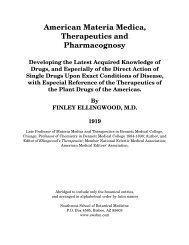SCARLET FEVER. Synonyms.—Scarlatina; Scarlet Rash. Definition ...
SCARLET FEVER. Synonyms.—Scarlatina; Scarlet Rash. Definition ...
SCARLET FEVER. Synonyms.—Scarlatina; Scarlet Rash. Definition ...
You also want an ePaper? Increase the reach of your titles
YUMPU automatically turns print PDFs into web optimized ePapers that Google loves.
disease.<br />
“Synochal and Synochoid Types.—Sometimes, owing to a more intense<br />
character of the exciting cause or to greater depression of the system,<br />
the fever assumes a still more grave form, and is known as synochal or<br />
synochoid, according to the length and gravity of the fever.<br />
“'In synochal fever there are but few premonitory symptoms, the onset<br />
being more or less sudden. The patient's attention is often first arrested<br />
by chilly sensations passing over the body, and a sense of dullness and<br />
languor. Sometimes the chill is well marked, in rare cases amounting to<br />
a rigor, but often the sensation of cold is but slight.<br />
“This chilliness is rapidly followed by reaction; the skin becomes injected,<br />
dry, hot, and burning; the countenance flushed and animated; the<br />
pulse frequent, full, strong, and bounding, rarely hard and oppressed;<br />
respiration is frequent, the respired air hot, and the mouth and nostrils<br />
dry; the bowels are constipated, and the urine scanty and high-colored;<br />
the tongue white, its papillae elongated and erect. The patient<br />
experiences great thirst, and manifests increased sensibility, especially<br />
in regard to light and noise. There is frequently some headache, with<br />
sometimes vertigo, and the patient is watchful, restless, and uneasy. In<br />
children it may commence with a convulsion.<br />
“As the disease progresses, these symptoms increase in severity; the<br />
secretions are still further arrested, the heat and dryness of. the skin<br />
increase, and the patient is more watchful and uneasy. All the<br />
symptoms are usually more exasperated in the evening and early part<br />
of the night. The fever continues to increase in intensity until about the<br />
fifth or sixth day, when there is a tendency to a crisis, and the disease is<br />
frequently arrested by the establishment of secretion. If it progress<br />
much beyond this period, we observe a manifest prostration, the<br />
symptoms being those of synochoid ; and in the course of as many days<br />
more, marked evidence of disorganization of the blood and typhoid<br />
symptoms. We rarely, if ever, see the disease terminate fatally as a<br />
synochal fever, unless complicated with inflammation of some important<br />
organ.<br />
The temperature in synochal fever has a pretty high range. Yet the<br />
wave-lines or difference between morning and evening temperature are<br />
well marked. The following table gives the variations of temperature in<br />
a fever terminating the fifteenth day:<br />
The Eclectic Practice of Medicine - PART I - Infectious Diseases - Page 255

















